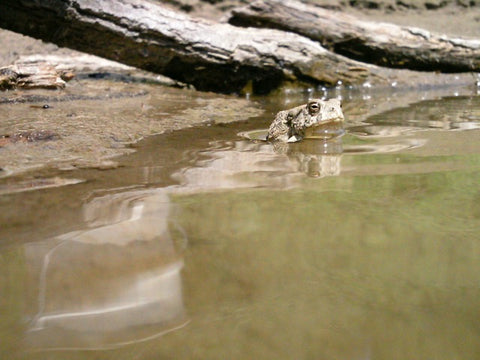Toads and frogs key to water quality
Researcher Niall Clancy touts the potential of frogs and toads in restoring native fisheries
By Evelyn Boswell
Frogs, toads and salamanders often fall through the cracks of scientific study, but according to recently published research from Montana State University, they play a role so important they should be incorporated into strategies for conserving freshwater fisheries.


In his first peer-reviewed paper as sole author, Niall Clancy, 22, said that native fish populations continue to decline around the world despite advances in management practices. Therefore, fisheries managers might want to add new approaches to the old.
Clancy is a 2017 graduate from the Department of Ecology in MSU's College of Letters and Science. His paper, “Can Amphibians Help Conserve Native Fishes?” was published in Fisheries, a monthly journal of the American Fisheries Society, the oldest and largest professional society representing fisheries scientists.
"A complementary suite of techniques and approaches is needed if management is to prevent further losses," Clancy said. "One such complementary approach is the preservation of organisms that maintain ecosystem processes and functions."
Amphibians -- those cold blooded creatures that need both land and water to complete their lifecycles -- are such organisms, Clancy said.
Wildlife biologists tend to overlook amphibians because they aren't fully terrestrial, Clancy said. Fisheries experts do the same because amphibians aren't fully aquatic. But in many flowing and standing waters, young frogs, toads and salamanders are the dominant vertebrates. They change water chemistry, redistribute nutrients and alter the habitat for fish and other aquatic organisms.
Clancy noted that the amphibians in his study can be both predator and prey. Bullfrogs eat young fish and fish eggs, for example. Fish eat tadpoles. Salamanders tend to be carnivores, while tadpoles are generally herbivores. Both affect their environment, but in different ways.
The actions of freshwater fisheries managers would be most effective where amphibian populations abound, Clancy said. To preserve or boost those populations, he suggested that managers remove invasive fish from lakes and streams and stop stocking hatchery fish in lakes that don't normally contain fish. Additionally, they could record the types and numbers of amphibians they encounter while conducting fieldwork.
When land is involved, fisheries managers might take on an advisory role, Clancy said. They could suggest limiting human activity where amphibians live in large numbers. They might encourage riparian buffer zones, the reduction of pesticide application near water, and maintaining or improving microhabitats that are important to amphibians. Among those microhabitats are rotting logs, leaves, dense tree stands and wetlands.
"Fisheries management plans that incorporate amphibians will likely be beneficial for much of the aquatic community," Clancy said.
His paper focused on two categories of amphibians -- one being toads and frogs and the other being salamanders. A third group, called Caecilians, is not found in North America, Clancy said. Caecilians are wormlike amphibians that live mostly underground in the wet tropical regions of South and Central America, Africa and southern Asia.
Clancy said his exposure to amphibians, fish and research came early.
His father, Chris, is a longtime fisheries biologist for Montana Fish, Wildlife and Parks, so Clancy and his sister often accompanied him when he was conducting fieldwork around the state. Chris Clancy still remembers them joining him several years in a row when he was electrofishing Camp Creek near Sula.
"They were too young to help, but they captured frogs and toads that they put in buckets of water," he said. "After showing them to us, they always let them go."
As a high school student and summer intern at the Rocky Mountain Laboratories (National Institutes of Health) in Hamilton, Clancy co-authored a paper on the stability of a tick-borne group of viruses in milk. Flaviviruses, as the group is called, include the West Nile, Zika and yellow fever viruses.
While attending MSU, Clancy's mentors were MSU ecologists Wyatt Cross and Andrea Litt. He also worked as a freshwater ecology technician in MSU's Department of Ecology, where he assisted graduate students with their fieldwork and lab analysis.
"When I first met Niall, it was clear that he was bright, motivated and passionate about freshwater resources in Montana," Cross said. "His accomplishments over the past few years -- and contributions to my lab group -- have been really impressive. Niall has a penchant for asking good questions and pursuing his interests."
After graduating in May, Clancy spent the summer in Miles City where he worked as a native species fisheries technician for Montana Fish, Wildlife and Parks. Now waiting to enter graduate school in January at Utah State University, he is working as a teaching assistant in MSU's Department of Ecology.
Clancy said his paper in Fisheries was a couple of years in the making. He noted that he had plenty of help from MSU researchers and his father, the fisheries biologist.
"I am impressed with the paper Niall wrote because he researched how amphibian populations may affect fish populations," said the elder Clancy. "Many papers have been written about the opposite scenario. He is a creative thinker, asks questions from an alternative viewpoint and is very interested in under-studied organisms."



